Mitch Bushuk
I am broadly interested in polar oceanography and interactions between ice, the ocean and the atmosphere and on a wide range of spatial and temporal scales. Below are descriptions of my main research interests.
Sea Ice Predictability and Prediction
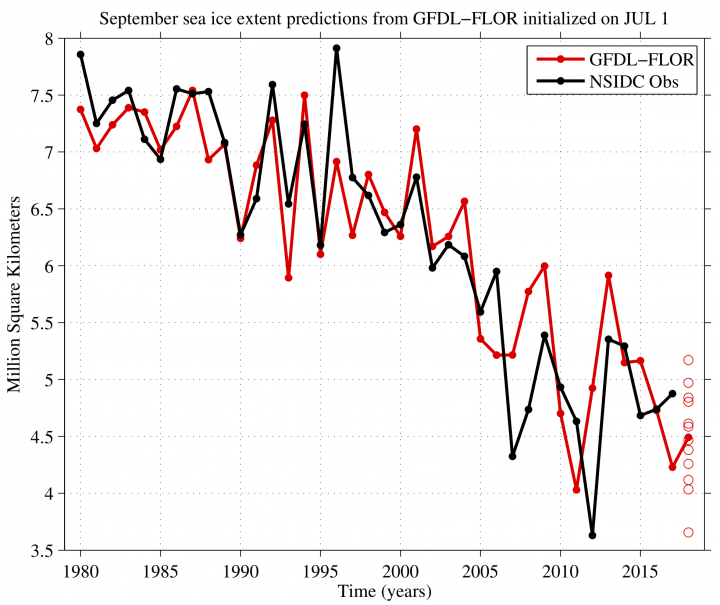
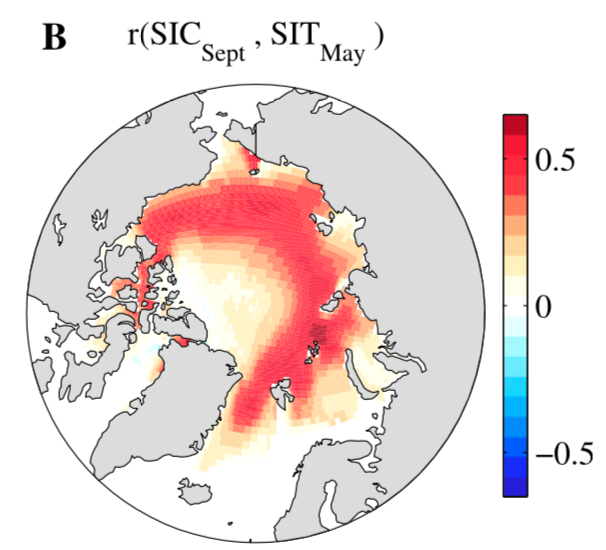
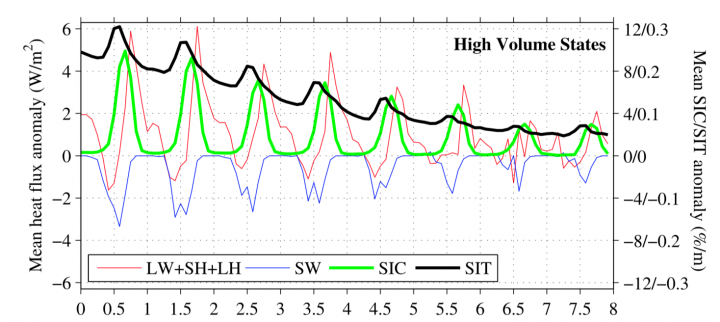
My research has a strong focus on the predictability of sea ice on seasonal to interannual timescales, with a goal of assessing the possibility for skillful operational predictions of sea ice in the Arctic and Antarctic. Sea ice is strongly coupled to both the atmosphere and ocean, and exhibits substantial internal variability and trends. The seasonal sea ice prediction problem is a mixture of an initial-value and boundary-value problem, with initial condition accuracy and coupled model fidelity both playing similarly crucial roles. I am working to understand sea ice predictability and prediction skill using a variety of GFDL model experiments–control runs, initialized prediction ensembles, data assimilation runs, historical simulations, and perfect model predictability ensembles–along with observational datasets. I have been submitting predictions on behalf of GFDL to the Sea Ice Outlook, which is an effort that collects predictions of September sea ice extent. We also submit predictions each month to the Extended Sea-Ice Prediction Network, which can be viewed here.
Improving these predictions requires understanding of the physical mechanisms that underlie sea-ice predictability, improved polar observations and data assimilation techniques, quantification of the limits of predictability for sea ice, and improved sea ice model simulations. I am working on projects related to each of these inter-related aspects of the sea ice prediction problem. Another important aspect of this work is its focus on regional spatial scales.
Relevant Publications:
- A spring barrier for regional predictions of Arctic sea ice
David Bonan, Mitchell Bushuk, and Michael Winton, 2019, Geophysical Research Letters, 46, 1-11, DOI: 10.1029/2019GL082947. - Regional Arctic sea-ice prediction: Potential versus operational seasonal forecast skill
Mitchell Bushuk, Rym Msadek, Michael Winton, Gabriel Vecchi, Xiaosong Yang, Anthony Rosati, Rich Gudgel, 2018, Climate Dynamics, 1-23, DOI: 10.1007/s00382-018-4288-y - Robustness of Arctic sea-ice predictability in GCMs
Ed Blanchard-Wrigglesworth and Mitchell Bushuk, 2018, Climate Dynamics, 1–12, DOI: 10.1007/s00382-018-4461-3 - Skillful regional prediction of Arctic sea ice on seasonal timescales
Mitchell Bushuk, Rym Msadek, Michael Winton, Gabriel Vecchi, Rich Gudgel, Anthony Rosati, Xiaosong Yang, 2017, Geophysical Research Letters, 44, 4953–4964. DOI: 10.1002/2017GL073155 - The seasonality and interannual variability of Arctic sea-ice reemergence
Mitchell Bushuk and Dimitrios Giannakis, 2017, Journal of Climate, 30, 4657–4676. DOI: 10.1175/JCLI-D-16-0549.1 - Summer enhancement of Arctic sea-ice volume anomalies in the September-ice zone
Mitchell Bushuk, Rym Msadek, Michael Winton, Gabriel Vecchi, Rich Gudgel, Anthony Rosati, Xiaosong Yang, 2017, Journal of Climate, 30, 2341-2362. DOI: 10.1175/JCLI-D-16-0470.1
Ice-Ocean-Atmosphere Interactions
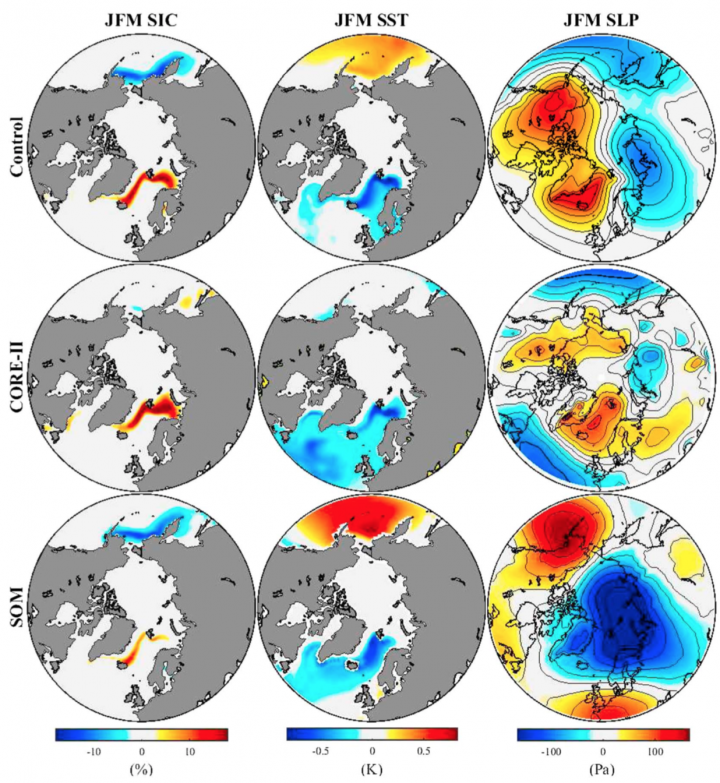
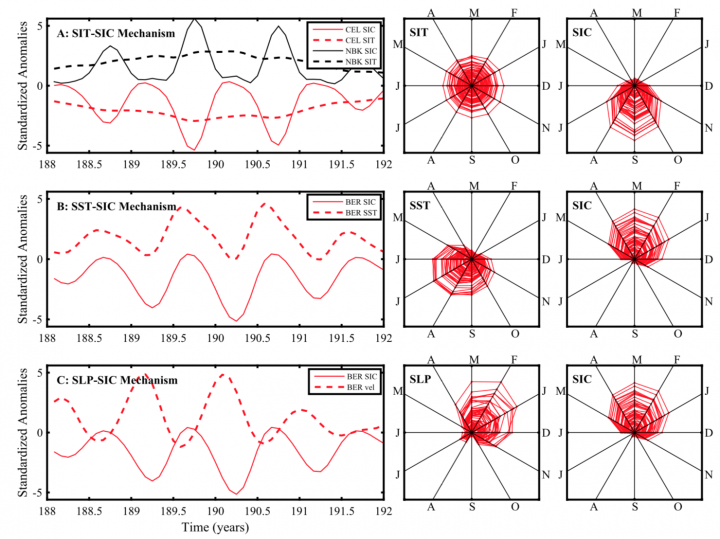
I am interested in the coupled variability of the sea ice, ocean, atmosphere system, and how both internal and forced processes in this coupled system drive sea ice variations on seasonal to decadal timescales. One aspect I have focused on is Arctic sea ice reemergence, a phenomenon in which (i) melt season sea ice area anomalies tend to reappear the following growth season, despite a loss of the anomaly over the intervening summer months; and (ii) growth season sea ice area anomalies tend to reappear the following melt season, despite a loss of the anomaly over the intervening winter months. We have examined the relative roles of the ocean, atmosphere, and sea ice in controlling the reemergence of sea ice area anomalies, identifying mechanisms for melt-to-growth and growth-to-melt reemergence. We focused on the seasonal and long term (decadal) variations of these mechanisms and their implications for sea-ice predictability.
Relevant Publications:
- Fingerprints of internal drivers of Arctic sea ice loss in observations and model simulations
Qinghua Ding, Axel Schweiger, Michelle L’Heureux, Eric J. Steig, David S. Battisti, Nathaniel C. Johnson, Eduardo Blanchard Wrigglesworth, Stephen Po-Chedley, Qin Zhang, Kirstin Harnos, Mitchell Bushuk, Bradley Markle, Ian Baxter, 2019, Nature Geoscience, 12(1), 28, DOI: 10.1038/s41561-018-0256-8. - The seasonality and interannual variability of Arctic sea-ice reemergence
Mitchell Bushuk and Dimitrios Giannakis, 2017, Journal of Climate, 30, 4657–4676. DOI: 10.1175/JCLI-D-16-0549.1 - Sea-ice reemergence in a model hierarchy
Mitchell Bushuk and Dimitrios Giannakis, 2015, Geophysical Research Letters, 42, 5337-5345. DOI: 10.1002/2015GL063972 - Arctic Sea Ice Reemergence: The role of large-scale oceanic and atmospheric variability
Mitchell Bushuk, Dimitrios Giannakis, and Andrew J. Majda, 2015, Journal of Climate, 28, 5477-5509. DOI: JCLI-D-14-00354.1 - Reemergence mechanisms for North Pacific sea ice revealed through nonlinear Laplacian spectral analysis
Mitchell Bushuk, Dimitrios Giannakis, and Andrew J. Majda, 2014, Journal of Climate, 27, 6265–6287. DOI: JCLI-D-13-00256.1
Sea Ice and Ocean Data Assimilation
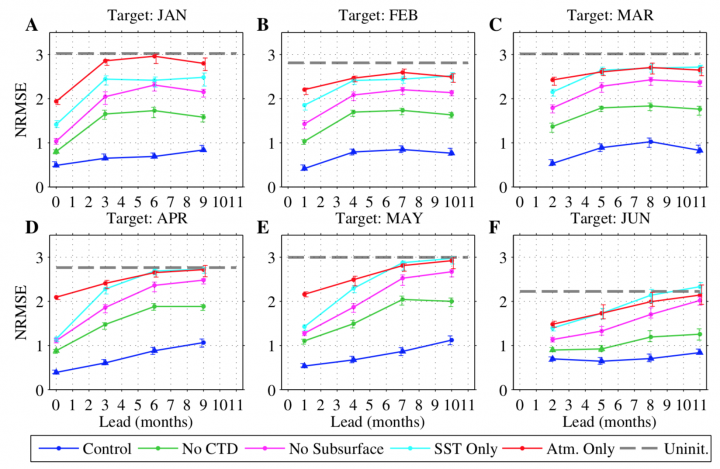
I am working on techniques for sea ice and ocean data assimilation, with the goal of improving initial conditions for seasonal sea-ice predictions. We have done work quantifying the value of different classes of ocean observations for winter sea-ice predictions. We find striking improvements in prediction skill associated with the assimilation of subsurface temperature and salinity measurements from conductivity-temperature-depth probes and from satellite sea-surface temperature data, demonstrating the direct value of these crucial observational datasets.
Relevant Publications:
- The value of sustained ocean observations for sea-ice predictions in the Barents Sea
Mitchell Bushuk, Xiaosong Yang, Michael Winton, Rym Msadek, Matt Harrison, Anthony Rosati, Rich Gudgel, 2019, Journal of Climate, 32, 7017-7035. DOI: 10.1175/JCLI-D-19-0179.1.
High-Dimensional Data Analysis Techniques
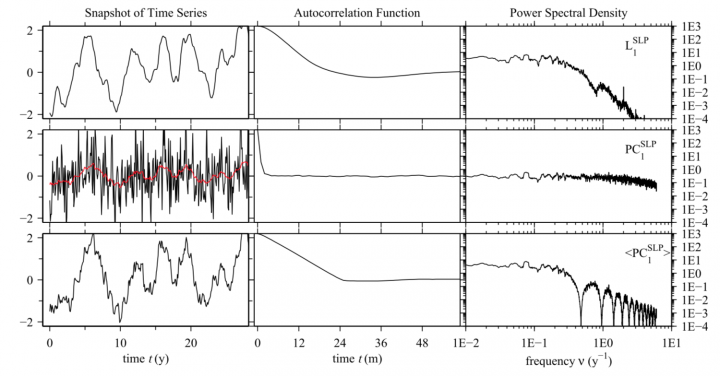
I am interested data analysis methods for high-dimensional nonlinear datasets. As part of my PhD work, I developed an algorithm called coupled nonlinear Laplacian spectral analysis (NLSA) designed to study the co-variability of multiple variables with different physical units. This approach generalized the NLSA method developed by Dimitris Giannakis. The technique combines concepts from dynamical systems theory and machine learning to extract coupled spatiotemporal modes of variability and offers a number of unique advantages compared to linear data analysis approaches.
Relevant Publications:
- Arctic Sea Ice Reemergence: The role of large-scale oceanic and atmospheric variability
Mitchell Bushuk, Dimitrios Giannakis, and Andrew J. Majda, 2015, Journal of Climate, 28, 5477-5509. DOI: JCLI-D-14-00354.1 - Reemergence mechanisms for North Pacific sea ice revealed through nonlinear Laplacian spectral analysis
Mitchell Bushuk, Dimitrios Giannakis, and Andrew J. Majda, 2014, Journal of Climate, 27, 6265–6287. DOI: JCLI-D-13-00256.1
Ice-Ocean Boundary Layer Turbulence
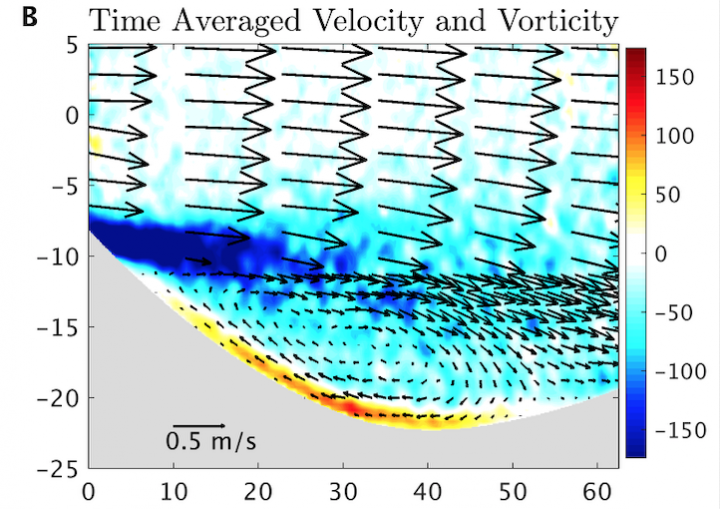
Ice scallops are a small-scale (wavelength 5-15cm) ripple pattern which form at the ice-water interface and are ubiquitous in nature. I performed a series of laboratory experiments at the Cold Regions Research and Engineering Laboratory (CRREL), collecting high-resolution (< 1mm) and high-frequency (15Hz) measurements of the turbulent ice-ocean boundary layer. Our primary finding was that scallops form due to a self-reinforcing feedback between the ice-interface geometry, shear production of turbulent kinetic energy in the flow interior, and the resulting differential melt rates that occur. Here is a video of a nice scallop pattern in an Antarctic borehole.
Relevant Publications:
- Ice Scallops: A Laboratory Investigation of the Ice-Water Interface
Mitchell Bushuk, David M. Holland, Timothy P. Stanton, Alon Stern and Callum Gray, 2019, Journal of Fluid Mechanics, 873, 942-976, DOI: 10.1017/jfm.2019.398
Glacier-Ocean Interactions

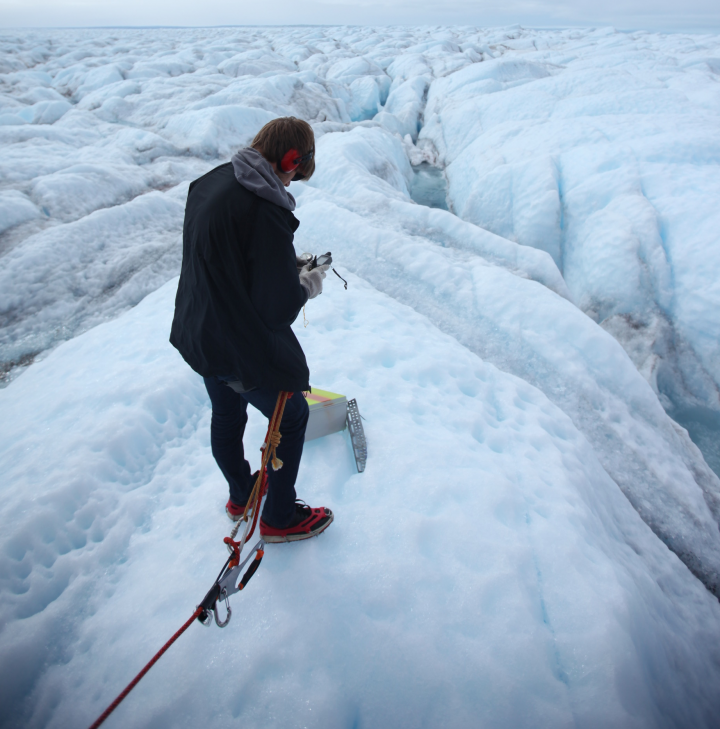
I worked with David Holland to collect GPS and Seismic data on Pine Island Glacier, Antarctica, as part of the Pine Island Glacier Project. Our research on PIG examined the glacier-wide velocity response to ocean temperature variability in Pine Island Bay between 2009 and 2014. We found that local ocean temperatures, averaged over the depth range of the thermocline, modulate the glacier’s flow and grounding line position, with ocean temperature changes of 1 degree C producing a lagged response in glacier speed of 4%.I also participated in David Holland’s field campaigns in Greenland. We collected oceanographic, glaciological, and meteorological data in and near Jakobshavn Fjord in West Greenland and Sermilik Fjord in East Greenland. Here are some video highlights from our work there.
Relevant Publications:
- GPS-derived estimates of surface mass balance and ocean-induced basal melt for Pine Island Glacier ice shelf, Antarctica
David E. Shean, Knut Christianson, Kristine M. Larson, Stefan R.M. Ligtenberg, Ian R. Joughin, Benjamin E. Smith, C. Max Stevens, Mitchell Bushuk, David M. Holland, 2017, The Cryosphere, 11, 2655-2674. DOI: 10.5194/tc-2016-288 - Sensitivity of Pine Island Glacier to observed ocean forcing.
Knut Christianson, Mitchell Bushuk, Pierre Dutrieux, Byron R. Parizek, Ian R. Joughin, Richard B. Alley, David E. Shean, Povl Abrahamsen, Sridhar Anandakrishnan, Karen Heywood, Tae-Wan Kim, Sang Hoon Lee, Keith Nicholls, Tim Stanton, Martin Truffer, Benjamin Webber, Adrian Jenkins, Stan Jacobs, Robert Bindschadler, David M. Holland, 2016, Geophysical Research Letters, 43, 10817–10825. DOI: 10.1002/2016GL070500


